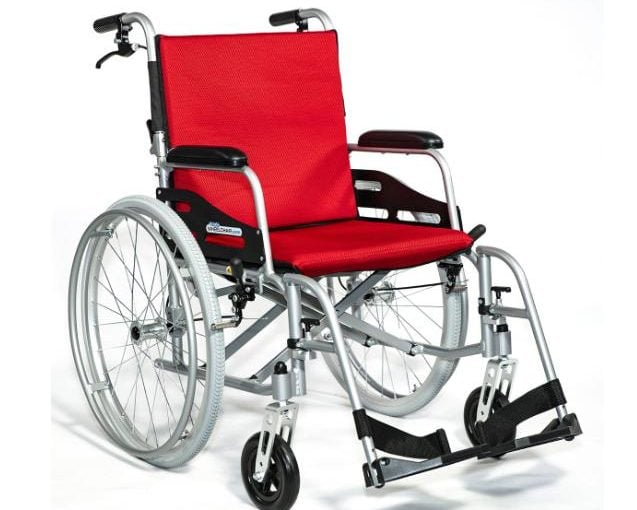Incredible strides have been made in wheelchair technology (just take a gander at our collection of featherweight wheelchairs at 1800wheelchair.com), to the point that we are now going from featherweight chairs, such as the model we offer here, to our all new even lighter featherweight transport chairs.
Predicting the future is a really tough gig. After all, how many people, taking epidemiologists out of the equation for a moment, could have anticipated a pandemic when COVID-19 hit? Still, by looking at the past and coupling it with what we see today, it may indeed be possible to predict what tomorrow’s wheelchairs will look and act like.
For many years, manufacturers went to painstaking lengths to shave ounces from the frames of lightweight wheelchairs, given that frame weight has long been scrutinized by ultra-lightweight wheelchair riders. You may be asking yourself, “Yes, but at this point, does losing a few more ounces really matter?” Perhaps the better question would be: If frame weight is no longer a significantly distinguishing feature, what else can manufacturers offer to stand out?
We can tell you, based on feedback from manufacturer reps we’ve spoken with, that it’s all about material – if it’s efficient, long-lasting and durable enough to withstand the design demands put on it. Whether it’s aluminum, titanium or carbon fiber, materials truly are a means to an end in the wheelchair industry, not just a bragging right for manufacturers to hype up; it really becomes a focus point for how to work with the material, where it’s sourced from and where it’s put together to ensure a wheelchair is as efficient as possible for the end user.
What we here at 1800Wheelchair.com would like to see as we glance into the kaleidoscope of future possibilities is freedom of riders to have more choices. Consumers and wheelchair users in particular are much savvier than they were even five years ago; they talk to other users, they enter chat/Facebook/TikTok groups and know what they want. We know for a fact that wheelchair riders are not going to want to hear “Sorry, this is all your insurance is going to cover,” so we’d like to see some changes in the area of freedom and choices.
We would also like riders to be able to match their chair to different activities, and for riders to have at least two chairs – the way we see it, having one chair to fit every activity 24/7 for, say, five-plus years, is absolutely ridiculous. It’s one of the reasons that people’s shoulders are wearing out, ultimately forcing them into a power chair.
We’d like to see more riders take control of their health and wellbeing by having two chairs – one for everyday use, one for special occasions or activities. We also think that a new era of customization would be great, so you can really tailor a chair to your individual needs.
Ultimately, as we look into the future of wheelchair technology, we are excited by what might be possible. While the technology today is impressive, it’s likely that there will be even more advances on the horizon. Whether it’s lighter and stronger materials, longer battery life or better customization options, wheelchair riders of tomorrow may have unprecedented levels of freedom to choose a chair that fits their specific needs.
Of course, one of the great advantages of lightweight wheelchairs is that they are relatively affordable compared to many other types of medical equipment. We think that this affordability should remain a priority.
Affordable wheelchairs give the user greater freedom and empower them to live their lives to the fullest, regardless of their physical capabilities. From lightweight folding chairs to power chairs and even transport chairs, we believe that continued focus on affordability will be key to improving access to mobility solutions for people around the world. We look forward to seeing what technological advancements are
The future does indeed look smart for wheelchair users, what with a host of companies experimenting with sensors and/or cameras positioned to provide feedback on a rider’s ability to control the device and navigate the environment safely. The information can be relayed directly to the user to modify behavior, such as through an auditory, sensory or visual feedback system, the data to then be tracked and used to provide therapists with valuable insight into the user’s driving habits.
The number of wheelchair users is growing, and with that comes the need to ensure accessibility. The power of technology should not only be harnessed to create a greater quality of life for wheelchair riders, but also to bring about an even greater level of freedom for those who ride them.
Here at 1800Wheelchair.com, we are excited by the possibilities, from our existing light and super lightweight chairs to our all new even lighter featherweight transport chairs. No matter what the future holds we can’t wait to see it!
So, where are we headed in the future pf wheelchairs? With advancements in materials, design and technology, the possibilities are endless. We hope that wheelchairs will continue to become more lightweight, accessible and affordable, so that all wheelchair users can experience freedom of movement and have access to the mobility solutions they need.
At 1800Wheelchair.com we’re proud to play our part in making mobility solutions accessible to everyone who needs them. We look forward to the future of wheelchair technology and how it can empower riders around the world!
